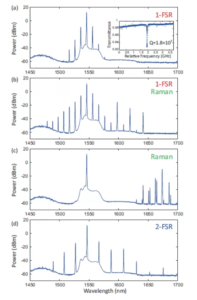CLEO 2018 Pacific Rim Ryo Suzuki
Research
CLEO Pacific Rim 2018 Participation Report
Ryo Suzuki, Doctoral Student, Tanabe Laboratory
We are writing to inform you of the following matter.
record
Participating Conferences
Conference: The 13th Pacific Rim Conference on Lasers and Electro-Optics (CLEO Pacific Rim 2018)
Dates: July 29 - August 3, 2018
Location: Hong Kong Convention and Exhibition Centre, Hong Kong
2. about CLEO Pacific Rim 2018
3. Presentation by the presenter
4. related announcements
W2F.2: High-resolution spectroscopy using a tunable dissipative Kerr soliton microcomb
Yong Geng et al., Univ of Electronic Science & Tech China
Although I have always read papers by microcomb research groups, I first became aware of this research group at this conference, where they confirmed soliton microcomb generation using a silicon nitride ring resonator, but with two lasers (pump and auxiliary lasers). One of the major problems in soliton microcomb generation is that the coupling of the pump laser to the resonator is thermally unstable. In this study, by pumping the auxiliary laser to the blue-detuning side, we compensated for the unstable coupling of the pump laser (red-detuning side) and obtained stable coupling of the pump laser and soliton microcomb generation. This idea is easily conceivable for microcomb researchers (in fact, I had considered it), but I felt that the key to success in this research is to be able to bring it to the stage where it can be studied in detail and demonstrated. In fact, considering the past examples of Tanabe Laboratory, we had been able to obtain initial ideas that anyone could have thought of, such as waveform shaping of microcomb, dual-comb generation of cw-ccw propagation, and crystal resonators with heat sinks. However, what was lacking, I felt, was a reasoned consideration of what phenomena were actually expected to occur, what parameters and equipment were needed, and what results and benefits could be obtained at the end.
W2B.4: Efficient four-wave mixing using CMOS-compatible ultra-silicon-rich nitride photonic crystal waveguides
Ezgi Sahin et al, Singapore Univ. of Technology and Design et al
ultra-silicon-rich nitride (Si7N3Silicon nitride, which is often used in microcomb research, is a silicon nitride material that is used in Si3N4is the This Si7N3has a nonlinear refractive index of 2.8×10-13 cm2/W (Si3N4In a photonic crystal waveguide with a waveguide length of 776 µm, a conversion efficiency of -37 dB was obtained for an input light of 13 dBm.


- Categories
- 国際会議報告



